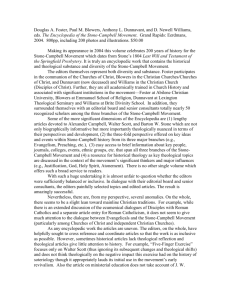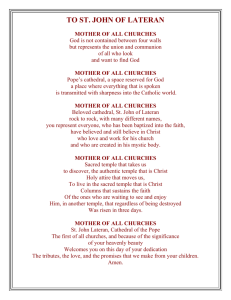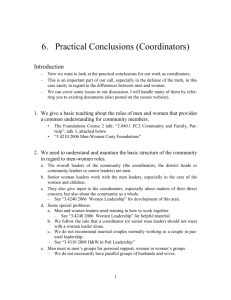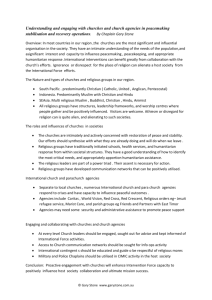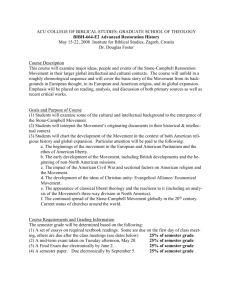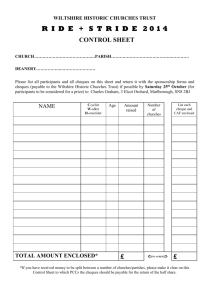Syllabus - Abilene Christian University
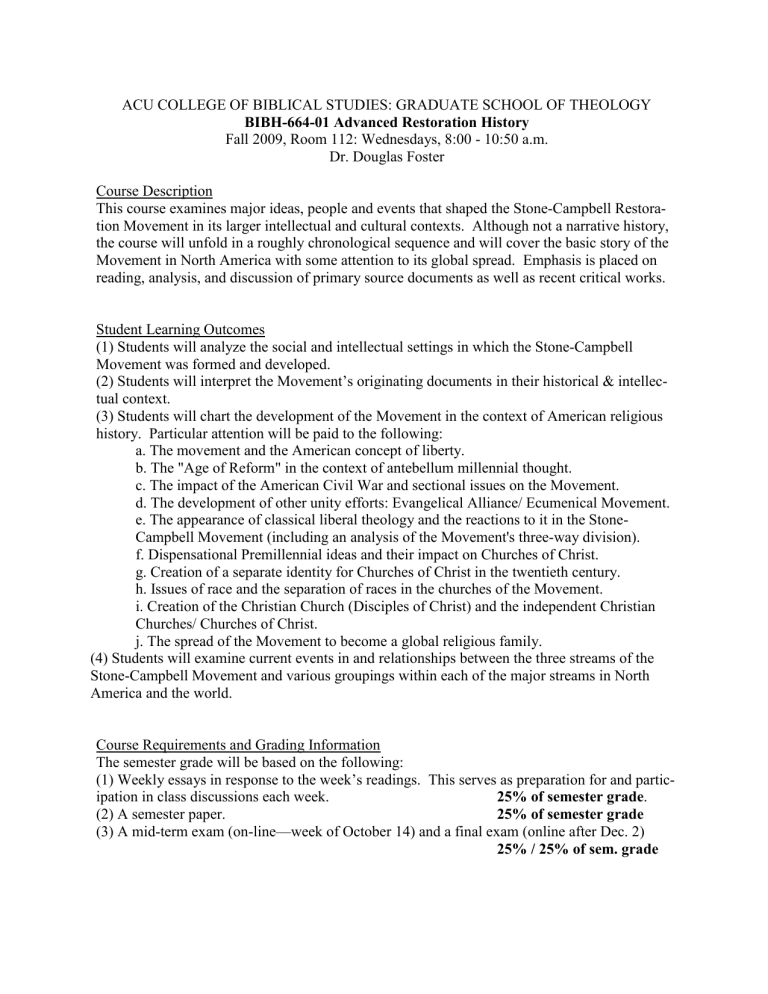
ACU COLLEGE OF BIBLICAL STUDIES: GRADUATE SCHOOL OF THEOLOGY
BIBH-664-01 Advanced Restoration History
Fall 2009, Room 112: Wednesdays, 8:00 - 10:50 a.m.
Dr. Douglas Foster
Course Description
This course examines major ideas, people and events that shaped the Stone-Campbell Restoration Movement in its larger intellectual and cultural contexts. Although not a narrative history, the course will unfold in a roughly chronological sequence and will cover the basic story of the
Movement in North America with some attention to its global spread. Emphasis is placed on reading, analysis, and discussion of primary source documents as well as recent critical works.
Student Learning Outcomes
(1) Students will analyze the social and intellectual settings in which the Stone-Campbell
Movement was formed and developed.
(2) Students will interpret the Movement’s originating documents in their historical & intellectual context.
(3) Students will chart the development of the Movement in the context of American religious history. Particular attention will be paid to the following: a. The movement and the American concept of liberty. b. The "Age of Reform" in the context of antebellum millennial thought. c. The impact of the American Civil War and sectional issues on the Movement. d. The development of other unity efforts: Evangelical Alliance/ Ecumenical Movement. e. The appearance of classical liberal theology and the reactions to it in the Stone-
Campbell Movement (including an analysis of the Movement's three-way division). f. Dispensational Premillennial ideas and their impact on Churches of Christ. g. Creation of a separate identity for Churches of Christ in the twentieth century. h. Issues of race and the separation of races in the churches of the Movement. i. Creation of the Christian Church (Disciples of Christ) and the independent Christian
Churches/ Churches of Christ. j. The spread of the Movement to become a global religious family.
(4) Students will examine current events in and relationships between the three streams of the
Stone-Campbell Movement and various groupings within each of the major streams in North
America and the world.
Course Requirements and Grading Information
The semester grade will be based on the following:
(1) Weekly essays in response to the week’s readings. This serves as preparation for and participation in class discussions each week.
(2) A semester paper.
25% of semester grade .
25% of semester grade
(3) A mid-term exam (on-line—week of October 14) and a final exam (online after Dec. 2)
25% / 25% of sem. grade
Advanced Restoration History
Weekly Essays
1) Each student will write a one to two-page single-spaced essay based on the readings for that class. This is not simply an outline of the material or a listing of facts; rather, it is your reaction or response to the ideas presented in the readings for that day. What did you find especially interesting and why? How were your ideas challenged or changed, or what did you learn that you think was especially important for your understanding of the Movement? What did you find difficult? What do you want to challenge or question? The essays must be posted to your
“Team” site in the Blackboard “Discussion Board” area no later than noon each Tuesday before class meeting on Wednesday. That means that you must stay ahead on your reading.
2) Each Team member will read the other members’ essays from the Blackboard site and be prepared to respond orally to your team mates’ ideas at the beginning of class each Wednesday.
The professor will mark the essays and send them back electronically before the
Wednesday class meeting most weeks.
These essays and your oral responses will serve as the basis for the beginning of class discussion some weeks. This will take various forms, including oral questions asked by the teacher, discussions and consensus building, identifying questions for the teacher to address in class, making choices for directions for the lecture, etc.
Each individual will receive a grade of from 0 to 5 points each week on her or his essay. It will be very important to spend adequate time on the reading of the texts, the writing of the essays, and reading team mates’ essays for class response and discussion.
Research Project
Early in the semester and in consultation with the professor each student will chose one of three options for the major project.
(1) The first option is to write a twenty-page paper dealing with a specific research problem in the history of the Stone-Campbell Movement.
(2) The second option is to write a critical history of the life of a congregation in the Stone-
Campbell Movement. A web-based course on writing congregational histories will serve as a starting set of instructions.
(3) The third option is to do a critical religious genealogy of some part of your family’s history in the Stone-Campbell Movement, raising questions concerning their involvement in one or more critical periods of the history of the Movement.
Regardless of which option you choose, the final project should consist of approximately twenty pages of text (with additional pages for accompanying illustrations or documents if desired), and will be done in four stages:
A. Turn in a written proposal for your paper/project no later than September 9.
B. Turn in an introduction, detailed outline and working bibliography by October 7.
C. Turn in a full-blown rough draft of the project, including documentation and bibliography on
November 11.
I will mark these and return them to you for use in writing your final draft.
D. Turn in the final completed paper/project on December 2.
Advanced Restoration History
Option 1
Students may choose a topic from the list at the end of this syllabus or from their own interests.
Proposed topics must be written out and given to the professor for approval, suggestions, and guidance as soon as possible–but no later than the beginning of class September 9.
Form should follow carefully Turabian style. There are different versions of Turabian today.
The information you will need for correct form can be found at http://www.bucknell.edu/Documents/ISR/turabian.pdf
Option Two
The congregational history project is to be a study that details and analyzes a critical historical event in the life of a congregation of the Stone-Campbell Movement. It is not a chronicling of year-by-year events, or an anecdotal collection of stories. This may be the congregation of which you are presently a member or another congregation worked out with the professor. The form can be a bit more flexible than a traditional term paper, but you must write clearly and critically, and all standard types of references (books, articles, web sites, oral history interviews, etc.) must be given in Turabian form as mentioned in Option One. The “Writing Congregational Histories” web course can be found at http://www.bibleacu.com/crs/wch/ While there are parts of the course that do not apply to your project, you need to go through the entire course to get a full picture of what could be involved. You may also find helpful items at http://www.discipleshistory.com/online/links/default.htm
Option Three
The religious genealogy project requires that your immediate family be members of one of the churches of the Stone-Campbell Movement and that you have access to family records and the possibility of doing oral history to determine the role of one or more family members in the history of the Movement. Like the congregational history, this is not merely an anecdotal history, but a critical examination of an event and/or discrete set of the ideas in American Christianity and the Stone-Campbell Movement that shaped your family—as well as how your family (one or more members of it) shaped the Movement.
____________________________________________________
Attendance Policy
Attendance is expected and required at all class sessions. If in the case of an emergency you must miss a session, you will be responsible for completing all assignments due, including turning in the essay from readings assigned and materials pertinent to the missed class discussion.
More than two absences may result in being dropped from the class.
Office Hours
Office 282 in the Graduate School of Theology. Office hours for Fall 2009 are as follows:
Tuesdays 8:00-11:00 am, 2:00 pm-4:00 pm; Wednesdays: 1:00-3:00 pm. If you need to visit at a time other than these, please make an appointment by calling my school phone number 674-
3795 or sending an e-mail to foster@bible.acu.edu
Advanced Restoration History
Required Texts
(1) M. Eugene Boring, Disciples and the Bible . Chalice Press, 1998.
(2) Douglas A. Foster, Will the Cycle Be Unbroken? Churches of Christ Face the Twenty-
First Century . ACU Press, rev. ed., 2007.
(3) Douglas A. Foster, compiler. Readings to Accompany BIBH 664 . Duplicated and made available through the ACU Bookstore.
(4) Nathan O. Hatch, The Democratization of American Christianity . Yale, 1989.
(5) Richard T. Hughes, Reviving the Ancient Faith: The Story of Churches of Christ in America. Eerdmans, 1996.
(6) D. Newell Williams, Barton Stone: A Spiritual Biography . Chalice Press, 2000.
(7) (Recommended—not required) Douglas A. Foster, et. al., Encyclopedia of the Stone-
Campbell Movement , Eerdmans, 2005. Note—buy on amazon.com.
Specific readings from the above texts and/or primary source material and articles in the
Readings book or on the class web page will be assigned for each week of the semester.
Other Suggested Reading: Standard Restoration Histories
By scholars from Churches of Christ
Gary Holloway and Douglas Foster,
Renewing God’s People: A Concise History of Churches of
Christ . Revised edition with study guide, 2006.
David Edwin Harrell, Jr., The Churches of Christ in the 20 th
Century , Univ. of Alabama Press,
2000.
Leroy Garrett, The Stone-Campbell Movement , Rev. & Expanded, College Press, 1994.
Bill Humble, The Story of the Restoration . Firm Foundation, 1969; reprint, Faith and Facts,
1993.
Earl West, The Search for the Ancient Order: A History of the Restoration Movement , 4 vols.
Gospel Advocate, Religious Book Service, 1949 ff.
By scholars from Independent Christian Churches
James B. North, Union in Truth: An Interpretive History of the Restoration Movement . Standard, 1994.
Henry Webb, In Search of Christian Unity: A History of the Restoration Movement . Standard,
1990; revised ed. ACU Press, 2003.
James DeForest Murch, Christians Only: A History of the Restoration Movement . Standard,
1962.
By scholars from the Christian Church (Disciples of Christ)
D. Duane Cummins, The Disciples: A Struggle for Reformation . Chalice Press, 2009.
Mark Toulouse, Joined In Discipleship: The Maturing of An American Religious Movement .
Chalice Press, 1992; revised edition 1997.
Lester G. McAllister and William Edward Tucker, Journey in Faith: A History of the Christian
Church (Disciples of Christ) . Bethany Press, 1975.
Winfred Ernest Garrison and Alfred T. DeGroot, The Disciples of Christ, A History . Bethany
Press, 1948, 1958.
Advanced Restoration History
Other Suggested Reading: Stone-Campbell Movement and American Religion
Dwight Bozeman, Protestants in an Age of Science . Univ. of North Carolina Press, 1977.
Jon Butler, Awash on a Sea of Faith . Harvard Univ. Press, 1990.
Michael W. Casey, Saddlebags, City Streets and Cyberspace: A History of Preaching in
Churches of Christ . ACU Press, 1995.
Anthony Dunnavant, et. al., Founding Vocation and Future Vision: The Self-Understanding of
Disciples of Christ and Churches of Christ . Chalice Press, 1999.
Richard T. Hughes and C. Leonard Allen, Illusions of Innocence: Protestant Primitivism in
America , 1630-1875.
Chicago, 1988.
William R. Hutchinson, Between the Times: The Travail of the Protestant Establishment in
America 1900-1960.
Cambridge, 1989.
David W. Lotz, ed., Altered Landscapes: Christianity in America 1935-1985.
Eerdmans, 1989.
Martin Marty, Modern American Religion , Vol. 1, The Irony of It All: 1893-1919.
University of
Chicago Press, 1986.
Martin Marty, Modern American Religion , Vol. 2, The Noise of Conflict: 1919-1941.
University of Chicago Press, 1991.
Newell Williams, ed., A Case Study of Mainstream Protestantism: The Disciples' Relation to
American Culture, 1880-1989 . Eerdmans, 1991.
Jim Woodroof, The Church in Transition . Bible House, 1991.
Robert Wuthnow, The Restructuring of American Religion . Princeton, 1988.
_____________________________________________
Proposed Course Outline/Class Schedule
Aug. 26 Introduction to Course. Discussion of topics for research. Personal involvement in the Stone-Campbell Movement. Read Nathan Hatch, Democratization .
Sept. 2 Discussion of Hatch. Discussion of the intellectual framework supplied by Enlightenment and Romantic thought.
Sept. 9 Begin looking at the Stone Movement. Examine "Last Will and Testament."
PROJECT PROPOSAL DEADLINE
Sept. 16
Sept. 23
Begin looking at the Campbell Movement. "The Declaration and Address."
SUMMIT/ Alternate meeting—Friday September 18. Breakfast at Professor’s home 2509 Lincoln Drive.
Compare and contrast the Stone and Campbell Movements sociologically, intellectually, theologically. Discussion of the "union" of the Movements in light of contemporary ideas of Christian unity. Examination of how the Movement fit into the "Age of Reform" in the early 19th century.
Sept. 30 The American millennial ethos and the Movement.
Oct. 7 Sectionalization and Civil War as a factor in shaping American religion and the
Movement. Historiographical problems.
PROJECT INTRODUCTION, OUTLINE AND BIBLIOGRAPHY DUE
Advanced Restoration History
Oct. 14
Oct. 21
Oct. 28
The development of ideas of Christian unity in American religion in the 19th century and the Stone-Campbell Movement's reaction.
Mid-term exam available on line (due by noon, Tuesday, October 20)
No new readings. Continue discussion of Christian Unity and the Movement.
The increasing importance of liberal theology on American religion in the late
19th century. The stances taken by the leaders in the Movement to biblical criticism and the uniqueness of Christianity. Examination of the differences in what would become the three major groups.
Nov. 4 The attitude about the new century, World War I, millennial ideas associated with the world events. Millennialism in American religion and the Movement. The fundamentalist crisis of the 1920s and the relation of the various segments of the
Movement to it.
Nov. 11 The second major division in the SCM. The shape of the movement at midtwentieth century. WWII.
DRAFT OF PAPER/ PROJECT DUE (no weekly essay)
Nov. 18 The emergence of the anti-institutional Churches of Christ and similar movements in American religion. The Movement and the crises of the 1960s. Social consciousness/ social abdication. The black Churches of Christ.
Nov. 25 Thanksgiving Holiday
Dec. 2 The restructuring of American religion. Factors now shaping the movement, characterization of the branches, and predictions for the future.
FINAL DRAFT OF PAPER/PROJECT DUE
Dec. 9 Final Exam (on-line exam) Deadline for returning: 12:00 noon
Advanced Restoration History
Some Possible Research Areas for Papers
NOTE: These are not ready-to-use topics or titles. Develop and refine, or supply an alternative.
State your topic in the form of a question or problem, i.e. "What accounts for the vast differences between Barton Stone and Alexander Campbell?"
1. Barton W. Stone's view of the atonement, or baptism, or another specific doctrine.
2. The fate of the Stone churches that did not enter the Stone-Campbell union.
3. The relationship between the Shaker communities and the Stone movement.
4. Thomas Campbell's European experiences with Christian division and unity.
5. The theological impact of other Christian bodies (like the Presbyterian and Baptist Churches) on the churches of the Stone-Campbell Movement and vice-versa. For example, how did the immersionist position of the Baptists influence the Movement; how did the Movement’s position on immersion influence the Methodists, etc.
6. The Stone-Campbell Movement's relations with other primitivist/ restorationist movements or unity movements.
7. The Age of Reform’s formation of “societies” and the development of structure in the
Movement.
8. American patriotism / nationalism and the Stone-Campbell Movement.
9. Differences between northern and southern conservatives before and after the US Civil War.
10. Millennial thought in the Movement.
11. Relations with other religious bodies: Baptists, Methodists, Presbyterians, Congregationalists, Universalists, etc.
12. Reactions to "liberal theology" in the broadest sense, i.e., Biblical criticism, evolution, comparative religion, etc.
13. The relationship of the Churches of Christ to the American fundamentalist movement.
14. The background and development of the anti-institutional controversy in Churches of Christ.
15. Continuing relations between Churches of Christ, Disciples and "Independents."
16. Historical changes in worship styles in the Movement.
17. Missions in Churches of Christ.
18. The spread of the Movement to the global south and implications for worship styles, leadership structures, etc.
19. The social consciousness of the churches of the Stone-Campbell Movement.
20. The Civil Rights Movement and the churches of the Stone-Campbell Movement.
21. Racial makeup of each of the North American streams of the SCM, for example, Black
Churches of Christ function as a separate group.
22. Diversification of theological positions within contemporary Churches of Christ, Christian
Churches, and/or Disciples of Christ.
23. The concept of Christian unity and the efforts toward unity among the different parts of the
Movement globally.
[At every turn you must constantly ask "why?" Although there will be times when you cannot arrive at a conclusive answer, be rigorous in your investigation of the problem factually and analytically.]

